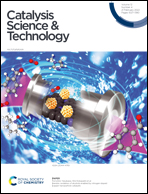Construction of a Z-scheme g-C3N4/NBGO/BiVO4 heterostructure with visible-light driven photocatalytic degradation of tetracycline: efficiency, reaction pathway and mechanism†
Abstract
In this study, an aminated graphene-like biochar (NGBO) was used as a solid-state electron mediator at a g-C3N4/BiVO4 interface to construct a hybrid Z-scheme system (g-C3N4/NBGO/BiVO4) for the photocatalytic degradation of tetracycline (TC) from aqueous solutions. The construction of the Z-scheme heterojunction led to the consumption of a photogenerated hole (h+). This promotes charge carrier transfer (e−) of g-C3N4, which ensures that the g-C3N4 is exposed with active sites, and shows a high efficiency for TC degradation. Among the composites of various ratios, the prepared g-C3N4/NBGO/BiVO4-0.5 presented the best degradation of TC when compared to other heterojunctions prepared under the same conditions, and the photocatalytic degradation rate constants of TC were enhanced significantly, being approximately 10.85 times and 2.70 times greater than that of pure g-C3N4 and g-C3N4/BiVO4, respectively. The response surface design methodology (RSM) was also used to optimize the parameters of the degradation of TC. The ESR measurement and radical quenching experiments indicated that the h+ and ˙O2− were mainly responsible for the TC degradation. The plausible mechanisms of the photoinduced electron transfer pathways and photocatalytic reaction degradation pathway of TC were investigated by experimental analysis. It is expected that the formation of graphene-like biochar-based Z-scheme heterojunctions would be promising candidate photocatalysts for environmental applications.



 Please wait while we load your content...
Please wait while we load your content...